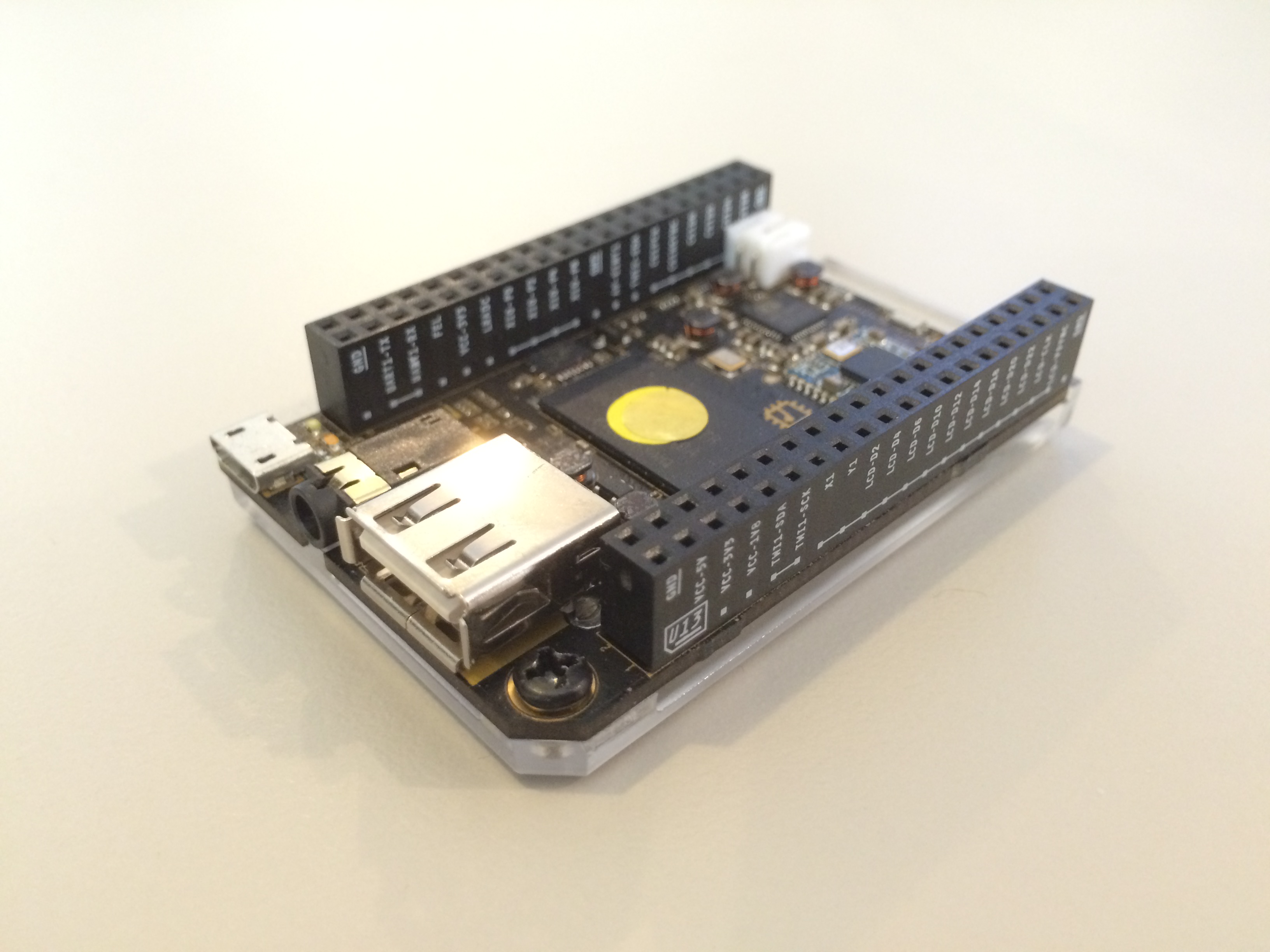Article summary
Almost a year ago, I participated in a Kickstarter for a $9 computer called CHIP. It’s similar to a Raspberry Pi, but with a few interesting differences. And surprisingly, it’s much cheaper.
I was a little skeptical. A lot of these projects end up as vaporware, and $9 is almost too cheap to be believable. But a few months later, my CHIP came! And it’s actually pretty sweet.
Lots of Attention to Detail
Even before I got to the more interesting features, there were a lot of things to like. The makers obviously paid a lot of attention to detail. For example, there are pin labels on the GPIO headers, which are unbelievably handy.

The USB port used to power the CHIP is also a USB serial device that gives you a tty on the CHIP. This means that even without a display or SSH access, I can get a console on the CHIP just by doing this:
screen /dev/tty.usbserial 115200
This was very handy for initial setup, as I didn’t have a display I could plug into it.
The basic specs are on par with a Raspberry Pi:
- 1Ghz ARM processor
- 512MB of RAM
Killer Features
The real highlights of the CHIP are the built-in flash, Bluetooth, and WiFi. The CHIP comes with:
- 4GB on-board flash
- Built-in Bluetooth 4.0
- Built-in WiFi b/g/n
The inclusion of those really lowers the cost of using the CHIP for an actual project. With a Pi, at the least, I have to buy an extra SD card, and I could easily spend $45 or $50 to get a similar setup with Bluetooth and Wifi.
Update: Since I wrote this post, the people that develop the Raspberry Pi have come out with the Raspberry Pi 3 that also has built-in Bluetooth and WiFi, which is pretty awesome. So the CHIP no longer has that advantage over the Pi.
Useful for Embedded Projects
Surprisingly, even though the CHIP is much cheaper than the Pi, I’ve found that is actually much more convenient (less wires and configuration) for many of the projects where I’ve used the Pi. I’ve been able to use the CHIP for:
- Running OpenOCD to make it function as a remote debugging server just as I’ve done with the Pi
- Transmitting BLE advertising packets
- Communicating with sensors and other embedded devices via the GPIO
Unfortunately, the CHIP is currently on backorder until June 2016. But once it gets out of backorder, and if it ends up staying at the $9 price point, I think it might replace the Pi as my go-to for prototyping embedded projects.


The RPi3 has BLE and is a quad-core Cortex-A53 with 1GB of RAM by the way.
The worst part of the CHIP is the GPU, which is more than trash.
But how many embedded projects actually need the GPU? I didn’t in all my projects in the last 12 months.
Well that is an acute observation. Encoding H-264 MP (720p @ 30 fps) and decoding likely any format up to Full HD (1080p @ 30 fps) is quite a task in such small formfactor. Certainly more than trash.
Include the support for OpenGL 1.1/2.0 and OpenVG 1.1 added with image inputs such as 8-bit CMOS plus CCIR656 for NTSC and PAL. I am going to describe it as powerful and feature plenty. It is not exactly meant for the 4k-market or specifically to video either.
Orange Pi One is quadcore too, 10$!
OK- but 4k video is a small portion of the embedded computer Marketplace. Especially given how few people today have a 4K video display.
So if you take that use case off the table, and you look at the huge variety of embedded projects that people are experimenting with… and you figure something like 4X the parts cost as your sales price… are you better off starting with a $9 chip or a $35 pi?
Especially if you’re going to blow up a certain number of the units in your experimentation. Every Hardware hacker has blown some chips and boards!
Certainly there’s a point where the base CPU price no longer dominates – if you’re going to spend $200 on the touch screen / display panel and a beautiful wooden frame and hang it on the fridge… a parts cost of 209 or 235 is less critical.
Can the chip be used on a iPad Air?
Damn it Paul…
For all non-high quality graphics projects, which is case with most of the electronics projects, this seems to be a nice n cheap option. Will surely try it out…
A bit shy on the details.
One advantage the Pi family has is that it’s software is rock solid. I have one that has been running for months with no reboots.
Does the CHIP offed similar levels of stability?
In terms of robustness it seems just fine. I’ve kept one up for a few weeks without issues, not even with the wifi connectivity.
In terms of maturity of the ecosystem it’s still not even close to what the Pi has to offer. If I want to hook some a weird sensor up to a Pi, chances are I can find a tutorial and example code on the web without hardly trying.
But, if I want to read some data with one of the ADC’s on the CHIP, I’m going to be lucky if I can find a driver.
Raspberry Pi’s run just fine until the SD card fails or get corrupted by a power failure. I’ve been burned multiple times, so I’m done with SD card based systems.
Thats not a very good review, is it?
It’s not labeled as a review, is it?
the web address is https://spin.atomicobject.com/2016/03/27/chip-computer-review/
so yes, I would say it is
It’s a light review. If it bothers you much, why don’t you write a more detailed review instead of complaining like an ungrateful little girl.